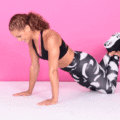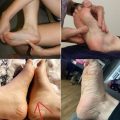What Is Arched Back?
Hyperlordosis is a condition in which there is an excessive spine curvature in the lower back. Hyperlordosis creates a characteristic C-shaped curve in the lower back, or lumbar region, where the spine curves inward just above the buttocks. It often occurs as a result of poor posture or a lack of exercise.
Hyperlordosis, too much curve in your back, can result in pain, a slipped disk, or other spinal injuries. Most often, lordosis is the long-term result of bad posture.
Other factors that can contribute to hyperlordosis include:
- being overweight
- pregnancy
- weak core muscles
- wearing high-heeled shoes for long periods
- spinal injury or disc problems
- diseases such as rickets or osteoporosis
- neuromuscular diseases, such as cerebral palsy
- sedentary lifestyle and lack of exercise
When your spine is excessively arched, it puts additional stress on muscles in your trunk, thighs, and hamstrings. Your muscles can become out of balance, tight, or weak.
Symptoms
Symptoms of hyperlordosis include lower back pain and a curved spine.
Hyperlordosis can cause muscle tightening and stiffness in the lower back. It can also damage the spine and soft tissues in the lumbar region.
A person with hyperlordosis may experience the following symptoms:
- A curved spine. Hyperlordosis leads to excessive curvature of the spine in the lower back, causing the abdomen and buttocks to appear more prominent in the profile view.
- Lower back pain. People with hyperlordosis may experience mild to severe lower back pain, which may worsen with movement.
There will be a fairly large gap when lying on a hard surface, and the buttocks will appear more prominent while the abdomen may protrude. Other symptoms include problems standing in one place for prolonged periods due to low back pain. Gymnastics is usually difficult for people with hyperlordosis. Other signs and symptoms may eventually include chronic fatigue and neck discomfort.
A simple test can check your posture: Stand up straight with your back pushed against the wall. With legs shoulder-width, your head, shoulder blades, and buttocks against the wall. Then, place your hand behind the lower spine. If you can place more than one hand between the back and the wall, then you have hyperlordosis.
What makes it worse?
Stress points that aggravate the arched back posture can include extended walking and standing, running, and lying flat on a hard bed.
Don’ts
- Sit on the edge of your chair with an upright back.
- Swim breaststroke and practice yoga poses like Cobra, Upward Facing Dog, and Superman.
- Use back support accessories with an arched shape.
Do’s
- Sit deep in your chair, with your back fully on the backrest. Your lower back “switches off” as there’s no pressure on it.
- Squat, cycle, and practice yoga poses like Cat Stretch and knees-to-chest to open up the lower back.
- Reverse crunches. They’re double duty, strengthening weak abs, and rounding the back.
How To Get Rid Of Arched Back
Fortunately, if you have an arched back, you can practice hyperlordosis exercises at home or with a physical therapist to get some relief. In 2021, the Indian Journal of Physiotherapy and Occupational Therapy included a study showing that a specific exercise protocol “conducted for 35 minutes/4 days/week … was significantly effective in reducing hyper-lordosis of the lumbar spine as well as improved abdominal muscle strength.” Similarly, a 2015 study published in the Journal of Physical Therapy Science found that some forms of exercise were effective at stabilizing the pelvis. But that study also offered certain cautions — and we’d like to do the same. While we will list some back arch stretches and discuss arching back exercise benefits, nothing should be considered medical advice. Always consult with your doctor or physical therapist prior to beginning a new exercise regime.
In the following list of arched back exercises and flexibility exercises, we will include a colloquial name (or an accompanying asana name if the exercise derives from yoga practice), basic instructions on how to perform them, and a link to a video if available. Again, please do not assume that any exercise is necessarily safe for your body. Consult with a physiotherapist or a physician.
With that being said, our list of exercises begins with:
- Swiss-Ball Pelvic Tilts: Sit on a large, inflatable, physiotherapy ball (aka a Swiss ball or yoga ball) so that your knees make a 90-degree angle as your feet meet the floor. Move your pelvis backward (which will cause you to round your back). Then arch your back (which will move your pelvis forward). Repeat in sets of 8 or 10. This will strengthen your abdominals and gluteus maximus.
- Kneeling Hip Flexor Stretch: Place some kind of soft pad on the floor and kneel. Lift and shift one knee forward, placing your foot on the ground. Tuck your pelvis forward, squeezing both your abdominals and gluteus maximus. Shift forward until you feel a stretching sensation in the leg with the knee still on the floor. Switch and repeat.
- Child’s Pose / Prayer Pose(Balansana): Kneel with your feet flat and your backward-pointing toes touching. Spread your knees slightly wider than the width of your body. Lean forward, pressing your face to the floor/exercise mat while reaching forward with your hands and tucking your tailbone. This back arch stretch helps reduce lower back pain.
- Cobra Pose(Bhujangasana): If you’re wondering how to get an arch in the lower back, then this exercise is for you. Lay flat on your face on the floor or on an exercise mat. Tuck your tailbone, press the tops of your feet down and place your palms underneath your shoulders. Then press your body away from the ground with your hands, lifting your head, shoulders, and lower torso. The benefits that this pose provides include stretching and toning of supporting abdominal muscles.
- Abdominal Crunches: Lay flat on your back with your feet flat on the floor. Dig in your heels, place your hands behind your head, and lift forward until your shoulders lift off of the ground or mat. Make sure that your lower back remains flat and that you don’t pull on your head or neck.
- Dead Bugs: The name may sound gross, but this exercise strengthens your core while keeping your spine in a neutral position. To perform it, lay on your back with your bent legs lifted and your arms extended over your head. Draw your navel toward the floor and flatten your back. Then straighten one leg until it hovers above the floor and drop the opposing arm as well. Draw both back up and repeat with the other side. (It’s hard to describe this one, so make sure to watch the linked video.)






